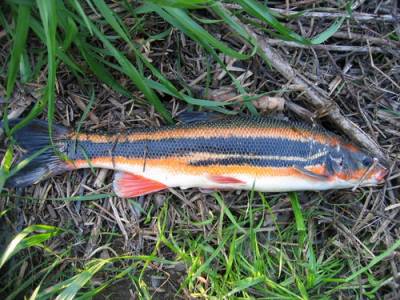Because
fresh waters are optically turbid in comparison with pure sea waters, curves of
photopic spectral sensitivity in freshwater fish are strongly displaced to the red part of the spectrum. For example, the
maximum of spectral sensitivity in largemouth bass, Micropterus salmoides, is near 673 nm (Kawamura & Kishimoto, 2002). For eyes of freshwater fish red and orange colors are brighter
than all other equipower monochromatic colors, in particular green and blue. This feature occurs in nuptial coloration
of fish with location of bright red colors on the under shadowed parts of the body,
in conformity with the theory of color countershading in fresh waters.
However,
there are as minimum two outstanding cases of nuptial coloration in freshwater
fish with location af red or orange colors on the upper most illuminated parts
of the fish’s body.
Fig.1illustrates,
perhaps, one of the outstanding examples of contrast melanin and carotenoid based
color patterns in freshwater fish. Bilateral longitudinal red (orange) and
black (dark) stripes are basic elements of nuptial coloration in males of the
anadromous Far-Eastern dace, Tribolodon
brandtii (Cyprinidae), and related daces. The maximum of spectral sensitivity
in T. hokonensis, adapted to the
optically turbid freshwater, is shifted to the red part of the spectrum and is
near 612 nm (Kawamura & Kishimoto, 2002). So, red stripes are brightest to
the eyes of tribolodons, herewith dorsal stripes are located on the upper most
illuminated parts of the body.

Figure 1. Anadromous Far-Eastern dace, Tribolodon brandtii (Cyprinidae), with nuptial coloration
Another
outstanding case of bright nuptial coloration on the upper most illuminated
parts of the body or even throughout the body occurs in anadromous Pacific
salmons.
Sockeye
salmon, Oncorhynchus nerka, display
the most extreme nuptial colors among other species of this genus, with the olive-green
heads and conspicuous carotenoid based red bodies in both sexes but brighter in
males (Foot et al., 2004). According to the same authors, in field experiments males
show preferences to abstract (three ribbed) female models of red color over models
of other colors in prespawning period and choose exceptionally red models
during spawning. The curve of spectral sensitivity in young O. nerka is adapted to fresh water with one
of the maximums at 635 nm (Flamarique & Hawryshyn, 1996), eyes of the adult
fish entered fresh water must be readapted to the corresponding optical
conditions.
The appearance of bright dorsal colors , both visible for conspecifics and predators, in anadromous fish can
be explained by the less predation pressure in fresh waters. As mentioned above, red or orange colors are determined by intensive fattening of daces and salmons on the crustacean (krill) carotenoid rich diets in the sea.
Basic References
Foote C.J.,
Brown G.S., Hawryshyn C.W. 2004. Female colour and male choice in sockeye
salmon: implications
for the phenotypic convergence of andromous and nonanadromous morphs. Animal
Behaviour 67, 69-83
Kawamura
G., Kishimoto T. 2002. Color vision, accomodation and visual acuity in
the largemouth bass. Fisheries Science 68, 1041-1046
Novales
Flamarique I., Hawryshyn C.W. 1996. Retinal development and visual sensitivity of young Pacific sockeye
salmon (Oncorhynchus nerka). Journal of Experimental Biology 199,
869-882




